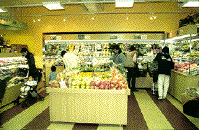 Science & Technology || Search || Back Numbers GOOD EATING:
 Organic foods are becoming a common sight in Japanese grocery stores. (Photo: Radish Boya) Organic foods have become a fixture at the Japanese table. Once limited to a small minority of finicky consumers, the popularity of organic foods has now spread to the general population. And whereas the term "organic food" once signified mainly produce, now organic processed foods are starting to appear as well. The market for organic agricultural products, including processed foods, is large: Estimates have placed it at 150 billion yen (1.3 billion dollars at 120 yen to the dollar). The popularity of organic products has also influenced the manufacturing and distribution sectors, creating new production and distribution systems that make it possible to better accommodate consumers' needs. Not Just Raw Foods Any More A small vinegar producer in Gifu Prefecture has received organic-food certification from a U.S. government-approved certification board for the past three years. Every year an American inspector visits the company to verify that the rice used in the vinegar is being cultivated organically. The inspector also examines the processing and distribution stages. The "organic" seal of approval carries a lot of weight; the company has seen its sales rise steadily. One frozen-foods manufacturer, which imports and sells frozen organic vegetables from the United States and New Zealand, reports that last year its sales of foods bearing the "organically cultivated, pesticide-free" label were 2.5 times the previous year's sales. Many other food manufacturers are also developing organic foods. Since June, a variety of products have come on the market, including vegetable juice made with American tomatoes, wine made with French grapes, and miso made with American and Canadian soybeans. Department stores used the products to attract sales during the fierce competition of the "Chugen" summer gift-giving season. Health and Environmental Concerns Competition in this market is heating up, and companies' ability to sell organic foods depends on how effectively they can convey to consumers the idea that their products are truly organic. Although the Ministry of Agriculture, Forestry, and Fisheries published guidelines on organic foods in 1992, Japan does not yet have in place an inspection and certification system, or the means of legal enforcement. An increasing number of manufacturers, therefore, are trying to win consumers' trust by obtaining product certification from the United States and other countries with strict inspection standards and well-established certification systems in place. According to a spokesperson for the aforementioned vinegar producer in Gifu Prefecture, the producer worked to earn certification from a U.S. organization because "smaller makers need to emphasize their distinctive qualities in order to compete against the big manufacturers." What spurred the company to seek organic-food certification from a U.S. organization, despite the fact that the rice and all other ingredients used in every stage of manufacturing the vinegar are produced in Japan, was that no government body or third-party organization exists in Japan to certify organic food. If the company simply affixed labels like "reduced pesticides" or "no pesticides" to its products without any certification to back those labels, the products would not win consumers' trust. This past May, one leading supermarket chain imported 15 tons of organically certified California rice. The rice, which the chain offered at 79 of its stores in the greater Tokyo area, sold out in two weeks. The keyword "organic" seems to be changing Japanese consumers' long-held perception that domestic produce is safe while that from overseas is not. Industry Moves to Set Standards The popularity of organic foods has also spurred new trends among producers and distributors involved in organic and low-pesticide farming. This past July, 78 producers' groups that ship directly to retailers gathered for the first time and established an umbrella association. Although organic produce has won kudos for its excellent flavor and the fact that it is highly safe, the producers are small and lack the power to set production standards and prices on their own. By banding together to create a larger organization, they hope to devise their own standards for product approval and quality evaluation, so they will no longer need to depend on governments or the market to do this. The producers' groups are also looking at creating a producer-led market distribution system. Organic foods are also gaining a solid position in the wholesale market. In June of last year, a major wholesaler at the Ota market in Tokyo--Japan's largest wholesale produce market--established a special division to handle organic and other select produce. In just a year's time, the company's total monthly sales have skyrocketed from 30 million yen (250,000 dollars) to over 100 million yen (830,000 dollars). The company now serves 180 producers' groups, and has received inquiries from growers all over the country saying they want to ship vegetables that would be difficult to sell via existing distribution routes. In the past, wholesalers have imposed strict conditions on growers and insisted that they be able to provide a stable supply of product. For this reason, it was generally assumed that organic fruits and vegetables would never become widely available through market-based distribution channels. Indeed, in the past, organic produce has reached consumers mainly by means of direct shipment from farms to retailers. Under pressure from consumers, however, large retailers are demanding a wide selection of fruits and vegetables, and as a result, organic foods are steadily finding their way into market-based distribution channels.  Edited by Japan Echo Inc. based on domestic Japanese news sources. Articles
presented here are offered for reference purposes and do not necessarily
represent the policy or views of the Japanese Government.
Edited by Japan Echo Inc. based on domestic Japanese news sources. Articles
presented here are offered for reference purposes and do not necessarily
represent the policy or views of the Japanese Government.
|
